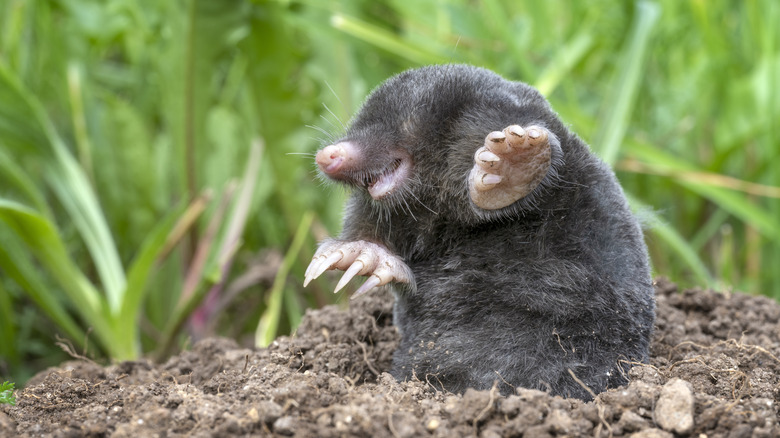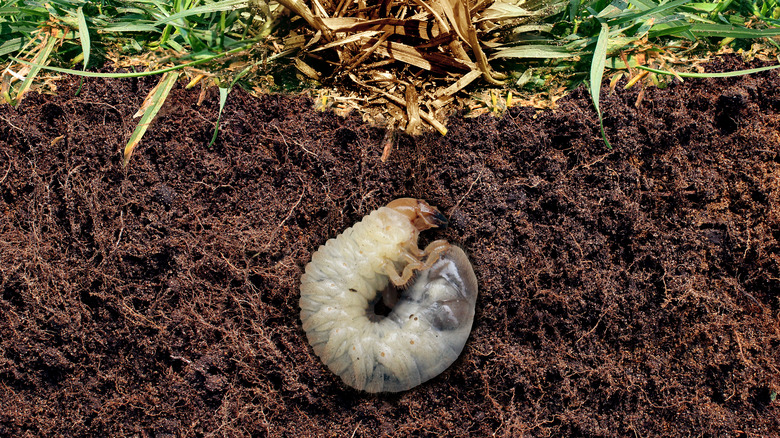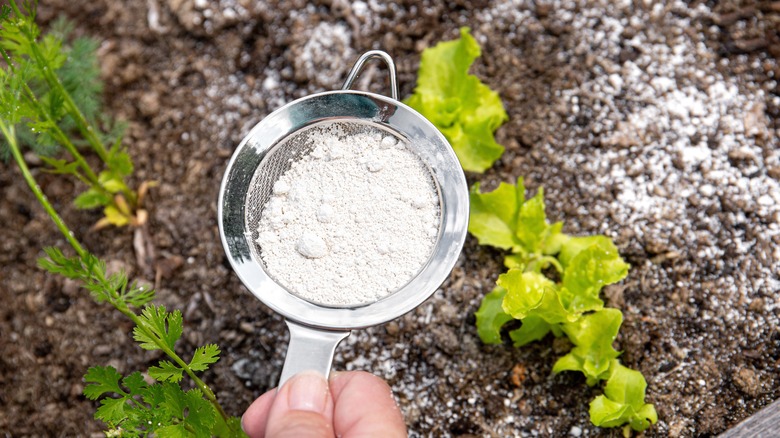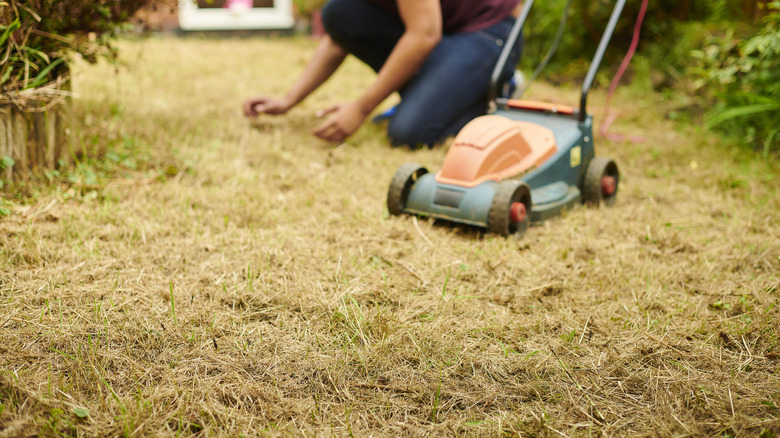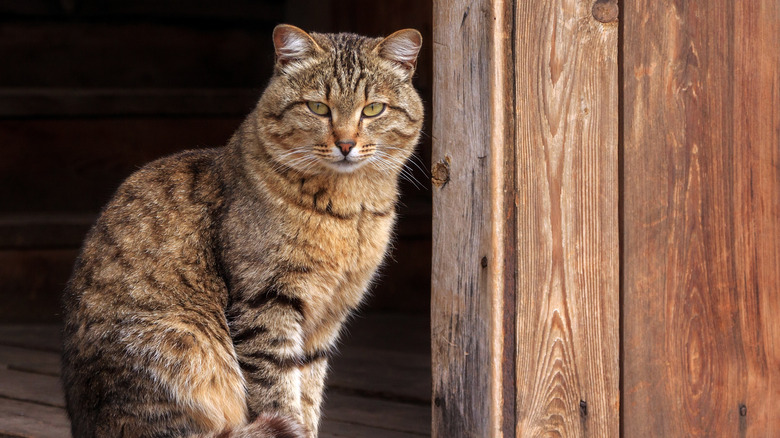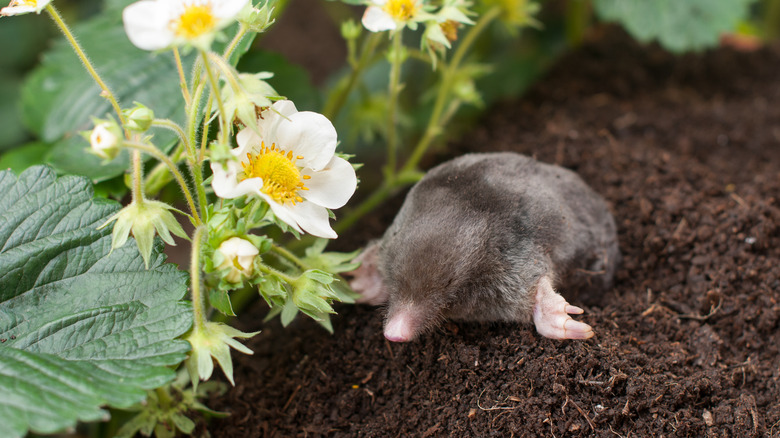Huge Mistakes That Are Attracting Moles To Your Yard
We'd like to talk to you about moles. No, not the ones that your dermatologist is recommending you get removed. We're talking about the kind of moles that dig beneath the earth. The ones with long noses, powerful digging claws, and perhaps the most awkwardly cute faces in the animal kingdom. Despite what "The Wind in the Willows" might have you believe about moles, they are not snuggly, harmless creatures. Quite the opposite actually. They have the ability to cause immense amounts of damage — to your yard.
Okay, we may have oversold you on the dangers of moles, but hear us out. There are mistakes that you might not even know you're making that are attracting moles to your yard. And once they are in your yard, it can be difficult to get them to leave. They will tear up turf, leave holes, and munch up a lot of your garden if you aren't careful.
Many of the mistakes we are about to list are ones that can very easily be remedied. However, don't think that because you are making them you are not being a good steward of your property. Moles can be very difficult to identify, to begin with. So, by knowing these mistakes you are going to be able to rectify them before you have an underground invasion on your hands.
Failing to repel insects
The chief reason moles are in your yard is because it provides them with an ample amount of food. And while moles will go after root vegetables and plant roots if they are really hungry, what they thrive on are insects. Here's where things get complicated, though. Moles thrive on exactly the kind of insects you don't want in your garden. Think grubs, armyworms, cutworms, and the like. "Oh" you might be thinking, "having moles around will be great! They'll get rid of these pests for me." Well, there's a catch.
Though they will feed on the overabundance of bad insects in your yard, they'll also feed on the good ones, like earthworms. Plus, once the moles come in, they are going to cause additional damage to your yard. And while moles are solitary creatures, they will come in numbers if there are enough grubs in your yard to feast on.
We will get to the use of repellents in a little while, but you need to know what is bringing those grubs to your yard in the first place. It's mostly because beetles and other insects have laid their eggs in your rich soil. So, if you don't already have preventative measures in place for these sorts of things, then you are really just inviting both insect pests and moles into your lawn.
Overwatering your lawn or garden
Another thing that moles love is damp soil. Dry, compacted soil is very difficult to dig through. Damp soil, on the other hand, is much looser and easier to dig through. Which is exactly why moles prefer it. Now, there are a number of different factors that could go into making soil the perfect dampness for moles. Some are natural, like consistent rainstorms. Others are more manmade, like overwatering your lawn and garden.
This is a classic mistake that many homeowners make that has served as a detriment to many lawns and gardens. Overwatering can drown plants and cause a whole manner of different diseases due to the excess moisture content. The water also loosens the soil, creating the perfect habitat for moles. They will happily dig along in that soil for as long as they can, eating away at bugs, and causing structural damage to your lawn and garden.
If you don't have a watering schedule or drainage systems in place, you really should. Obviously, if you have timed irrigation systems and well-draining soil, this isn't really anything to worry about. But if you're in the habit of watering your garden every day until it puddles, back off. Touch the soil. If it is still loose and moist, leave it alone. It'll survive to be watered another day.
Not using repellents
Now we get to the thing you should've been doing before those grubs and whatnot got into your yard and turned it into a mole feast in the first place. If you are not taking precautions to repel moles, and that which they eat, you are essentially telling them it is open season in your yard. That's the short truth of it.
So, what can you use to repel moles? Well, we recommend using all-natural repellents. Castor oil is an oft used repellent for moles. It doesn't repel them by using scent, as garlic does, but will instead repel them with a bitter taste that leads to stomach trouble. It can even kill them if they ingest enough of it. Some other excellent food-based repellents are cayenne pepper, peppermint, bay leaves, coffee grounds, and cinnamon.
You could also consider using ultrasonic repellents. These come in the form of little rods that send ultrasonic vibrations through the ground. Since moles are practically blind, they rely on scent and hearing to find their way around. The vibrations will affect their hearing, causing them to become discombobulated and, therefore, leave the area for more familiar sounds.
Not cleaning up your yard
Yard clean-up is one of those outdoor chores that no one really likes to do but it is necessary for maintenance and lawn well-being. And though there are certain methods of gardening that stress ground cover and water retention, if you are leaving too many areas in your yard unchecked, you are, by default, creating the conditions that are perfect for attracting moles.
Much like overwatering can create the optimal damp conditions that moles absolutely love, so too can the areas of your yard that have not been cleaned up. Piles of leaves or deadwood help hold the moisture in the ground, which in turn softens it and makes it much easier for moles to move around. They also provide ample protection from predators.
One of the best solutions to this problem is to create specific areas, well away from the prime points of your yard and garden, where you can easily dispose of your natural material. Compost piles or bins work incredibly well for this. Most town recycling centers will also have a place for brush and leaves if you don't have anywhere to put them yourself. However you choose to clean your yard, make sure you're keeping on top of it so you don't inadvertently create a wonderful area for moles.
Having an excess of bird feeders
Avid birders take note. While it may be well and good for those who love visits from songbirds or try to attract rarer birds to their porches and yards with the promise of delectable seeds, too many bird feeders can actually end up bringing a lot more than tweets to your yard. Bird seed, suet cakes, and any other edible measure you use to attract birds can also attract the likes of deer, squirrels, chipmunks, coyotes, and, of course, moles.
Though moles are carnivorous, preferring the juicy meatiness of a good worm over some seeds, they will not turn their sometimes star-shaped noses up at the thought of eating birdseed. Now, unlike squirrels who climb up feeders, or deer who can reach them from the ground, moles are much more strategic in their approach. No birdseed is ever going to remain entirely in the feeder. In fact, quite a lot of it is going to end up on the ground and down in the soil. This is where the moles will come after it. It is a game of patience with them, but also blind opportunity.
Now, you can't prevent birdseed from your feeders from finding its way to the ground. What you can do, however, is limit the number of bird feeders you have to only a handful placed in very strategic locations around your yard.
Poor lawn maintenance
If cleaning up your yard is going to be one of the best ways of keeping moles from entering, then proper lawn maintenance should occur in unison. It may seem ironic, but a healthy, well-maintained lawn is not actually a place moles want to be. If your lawn is well-kept, there is nothing for the moles to feed on. Grubs will be few and far between, and all the earthworms will be busy breaking down leaves and other organic matter in the woods. Therefore, a well-kept lawn provides them with no real opportunity to survive.
Everyone is going to have their own lawn care routine, but if you keep it well-watered and do your due diligence to keep insects and other pests from invading, then it is not going to present any appeal to a mole. A bad lawn, on the other hand, presents endless opportunities. A lawn that is ripe with all of the things that moles love to eat and dig through, is going to present you with enough challenges to deal with. Moles are only going to add to your frustrations. So, do yourself a favor and take care of your lawn. It'll up the resale value of your house, and keep moles away.
Not owning a cat
Hear us out on this one, okay? We understand that not owning a cat is not a prerequisite for inviting moles into your yard. We also understand that some of you might be allergic to felines and, therefore, cannot own one. The reason we are putting it on here is that not owning a cat can, in fact, be a mistake you are making in your fight against moles.
Cats are natural hunters, and they will go after a lot of different animals from birds to mice to rats. Moles are on their list of prey. Outdoor cats are extremely beneficial to farms and gardens. They help out by taking care of a whole manner of different pests that could invade your home, ruin your crops, and serve as an overall nuisance to you.
Many states will have animal shelters that specialize in barn cats. There are also shelters and state counties that create barn cat programs, which specifically match farmers and rural citizens with defensive cats for their property. Overall, they are just exceedingly beneficial to have as a defense against moles in your yard, and other pests in your home.
Not planting strategically
Now, moles, like the average commuter, love a wide-open freeway. This means that they do not like it when obstructions block their path from one end of a field to another. This is where strategic planting comes into play. What do we mean by this? What we mean is that the planting strategy for your yard should disrupt the moles' highways. Replace those open, grassy areas with a line of thick-rooted shrubs. The roots will block any free-forward movement the moles have, forcing them to go back and rethink their own strategy.
Strategic planting could also mean using raised beds instead of directly sowing your crops into the ground. Raised beds put several layers of compost, wood chips, and logs between the plants and the actual ground. Plus, to many, raised beds are more aesthetically pleasing.
You could also replace plants that require heavy watering with ones that are more drought-resistant. This means that they won't need to be watered as much and, therefore, will not pose the threat of turning your yard into the kind of damp symphony that moles so love.
Not installing physical barriers
Another aspect of this strategic planning initiative is to install physical barriers around your property. Nothing is going to stop a mole in its tracks more than metal or wire that is buried beneath the earth. Not all metal and wire are created equal, however. You are going to want to make sure that you are using a material that the moles can neither chew nor squeeze through. If you plan on using hardware cloth or wire mesh, make sure that you opt for one with a grid structure of 0.25-in openings. No mole is going to be able to squeeze through that small of an opening.
Other materials that work for this include sheet metals, such as aluminum, copper, stainless steel, and anything else garden beds or fencing could be made out of. You want to make sure that the part of your yard that you feel is most vulnerable to moles is protected. So, building a fence around prized flower beds or vegetable gardens is going to be a good idea.
If you keep chickens, it would behoove you to set up barriers like this as well. Chicken coops can create the type of warm, moist, worm rich environment moles love. So, creating a physical barrier that keeps them from getting in is only going to benefit you.
Being unwilling to do what needs to be done (sometimes)
Finally, there is a failure to do what needs to be done — sometimes. We do respect and understand that there is a cuteness factor with moles. As we said at the very beginning, the media portrayal of moles as helpless and harmless little creatures hasn't helped make them any less adorable. Their size doesn't make things easier either. However, if you truly want to protect your yard from moles, you need to be prepared to do dispose of them.
If you are not mentally or physically prepared to trap, poison, or dispose of moles that are doing damage to your yard and home, you are making a mistake. Sometimes, pests just need to be dealt with. That is the truth of it. We're sure some of you might disagree, but the fact remains that, especially if you live rurally and are dependent on what you produce, you need to be prepared to kill pests who are invading your area. How you do it is entirely up to you. Call a professional if you can't face doing it yourself.
None of these mistakes are ones that cannot be remedied. Moles are not the be-all-end-all pest in the same way some insects are. Still, there are reasons enough not to want them around. Hopefully, by understanding some of the mistakes that are attracting them to your yard, you will be better able to repel them in the future.
